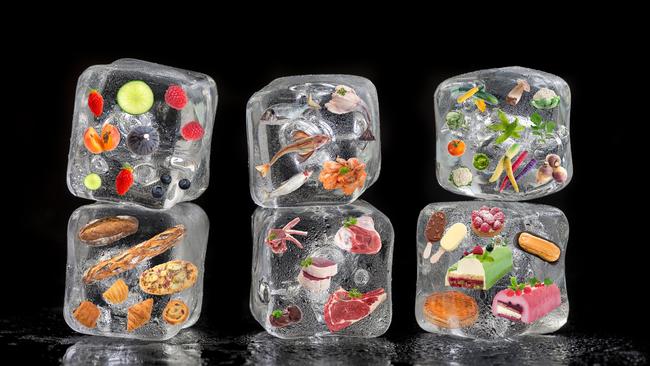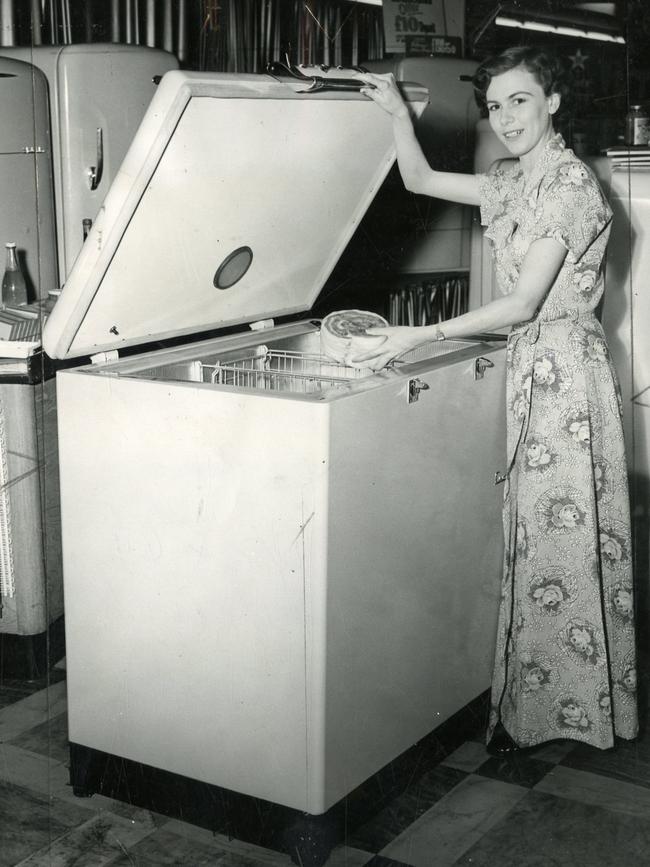Coronavirus: How to stockpile frozen foods
Retailers have reported a spike in sales of freezers due to COVID-19. Here is your ultimate guide to freezing food the right way.

For “end of days” conspirators and doomsaying billionaires, the air-filtered, zombie-proof desert bunker might be the answer to worries about COVID-19.
However, slightly more prosaically and certainly much harder to squeeze yourself into, there is the humble chest freezer.
This week, retailers reported a spike in sales of chest and under-the-counter freezers in Britain.
Last Wednesday, ao.com had its third-biggest one-day sales figures for freezers. The popular British “high street” frozen food retailer Iceland has also reported a surge in sales, as people anticipate the possibility of a significant period of self-isolation or even curfew.
“I can’t think of anyone who wants to benefit from this horrible virus, but we have seen sales of some items triple,” says Iceland joint managing director Nigel Broadhurst. “Diced onion has gone mad. Poultry, pizzas and fish are also in very high demand.”
For once I feel ahead of the curve. I have a chest freezer in the basement and a small freezer compartment in my kitchen fridge and have been panic-buying for years. That’s because there are seven in my family, including five children aged between 17 and 22.
In terms of ensuring day-to-day survival and maintaining family harmony, our 199-litre chest freezer is the second-most-essential appliance — after the superfast modem (third place: the six-slice toaster). We must never run out of anything.
We’re not the only family to feel this way. If you lost trust in freezer food during the dark days of the 1970s, be assured that the white bunker my dad used to call the “frosty coffin” is back.
In Britain, frozen food was enjoying a resurgence even before the present urge to hoard.
Kantar data for last year shows sales of £6.3bn, the second-highest figure to date — 2018 was the highest so far, driven by ice-cream sales in the hot summer.
Flat freezing
Keeping your icy poles rock solid is one thing, but Justine Pattison believes that, used properly, a freezer can be your best friend in the kitchen.

The author of Freeze, a collection of recipes and tips for the freezer owner, she has pioneered a form of batch-cooking called “flat-freezing”. You make stews, casseroles, soups or curries, pour them into plastic zip-lock bags and, leaving a small amount of room for expansion, stack them in 2cm slabs on trays in your freezer.
“If you don’t allow air to get into the bags, they will be perfectly edible in three or four months’ time,” she says. “But always date and label what you have and try to keep soups or curries in distinct areas so that you are not rummaging around wasting time and compromising freezer temperature.”
With stacking, there is minimal waste of space, and if you bag your food in easily usable portions there is minimal food waste too. When you come to defrost your frozen food, the 2cm thick slabs are easily cooked from frozen in a broad-bottomed pan.
“Some people I know are fussy about rotating their frozen food,” she says. “It helps to remind one what’s at the bottom of a large chest, and if yours is a busy household where people are opening the freezer door often, then that might lead to some temperature variation; in that case, the deepest part of a chest freezer is best for large meat joints.”
Beware the UFO
When batch-cooking for the freezer, I have found that washed ice-cream tubs (for family meals) or Lurpak butter tubs (for individual portions) generally work well. However, failure to follow basic clerical etiquette for batch-cooking can be disastrous.
I once froze individual portions of my admittedly challenging but germ-busting madras curry in some plastic Chinese takeaway containers. I forgot to label and date them and one fell to the bottom of the freezer to become what is known in the freezer community as a “UFO” (unidentified frozen object). A full year later my daughter took an ice box to Glastonbury with a handful of plastic ice blocks from the freezer. One of them was a brick-hard oblong of frozen madras that soon defrosted in the Somerset sun with devastating results for her camping group.
Curries aside, there is a lot of misinformation as to what exactly can and can’t be frozen and for how long. Cheese, if grated, can be frozen and applied without being defrosted for pizza toppings or cheese on toast. Eggs can be frozen if separated first (label how many egg whites or yokes are within a tub if you intend to use them as ingredients). Even double cream can be frozen if whipped, and vegetables such as avocados (peel and take the stone out first, and expect it to taste rather more oily than fresh), chillies and garlic are freezable too.
Really organised cooks will freeze pancakes (interleaved with greaseproof paper), which can be toasted from frozen, not to mention ice cube trays filled with wine for sauces.
Ripe fruit is often wasted, but can easily be frozen if you take a tip from chef Hugh Fearnley-Whittingstall: place it on a baking tray (chop bananas and halve strawberries first and put ripe pear into ice cube trays) and once it’s frozen, bag it up and return to the freezer as a smoothie mix.
Follow the rules
There is an art to defrosting too. I try to plan big family meals, which means I can put some of my frozen food from the supermarket straight into the fridge for very slow defrosting (a frozen chicken will take days, but saves valuable freezer space), and there are some supercool mavericks who say that meat defrosted in a fridge can be refrozen if you change your mind.
Professor Judith Evans from London South Bank University is an expert on the food “cold chain”, the passage of food from freezing at source to shop, then home freezer. Meat refrigeration, she says, is a high-stakes affair. If you are willing to peek through the fridge door, monitoring the conditions of your organic pork shoulder as though it were a priceless Renaissance masterpiece, you might be OK. If you don’t even know where the temperature dial in your fridge is, don’t take risks.
“A fridge should be kept at about 5C,” she says. “At that temperature, bacteria might grow on your meat, but very, very slowly. Refreezing it at -10C to -12C would kill any bacteria — most freezers operate at -18C — so if you were very confident in your fridge you’d probably be OK. However, the safest way is to buy a fridge with a dedicated meat drawer.”
In terms of cooking, always steam frozen vegetables because boiling them destroys valuable micronutrients, and always cook fish defrosted at ambient room temperature straight away. I also semi-thaw oven chips before use, so they cook faster and get crisper.
As for the fish that goes with them, my health-conscious eldest daughter is highly sceptical of my Aldi tuna steaks, which, the packet tells me, were frozen in Vietnam in October last year and will still be OK to eat until October 2021.
Are, “fresh” tuna steaks from a supermarket fish counter really any better, as she insists?
Evans thinks my frozen tuna just edges it. “Everything depends on two factors,” she says. “The quality of the fish — or indeed vegetables — and the speed at which they are frozen. ’’
There is evidence to suggest that in both cases you retain most vitamin content if you freeze fast.
Bolstering nutrition
“By contrast, some supermarket counter fish may already have been frozen once or refrigerated and a few days old,” Evans says.
“It’s certainly edible, but we know nutrient content starts to decline quickly.”
In fact, such is the efficacy of the modern “cold chain” that Evans never buys ambient-temperature food to freeze, but always specialist freezer-section produce.
“Industrial freezing is done by powerful air blast, which ensures deep and fast freezing,” she says.
“That’s key to retaining flavour and nutrients. Ironically, many people buy chiller foods and then freeze them because they think the quality will be better, but often it’s not.”
Helen White, a food waste expert from the charity WRAP (Waste and Resources Action Program), says the household freezer as an environmentally friendly tool.
Its research shows 4.6 million tonnes of edible food being thrown away each year (potatoes and bread most commonly, but also 100,000 tonnes each of pork and chicken).
“We think freezers are great, but the supermarkets can do more to help,” she says.
“We encourage them to display the snowflake icon on their foods (which signals that it can be frozen) more prominently and more widely. We have been asking supermarkets to stop labelling foods ‘freeze on day of purchase’ because there’s absolutely no reason not to freeze it on the ‘use-by’ date.
“When we buy a yellow-stickered bargain we tend to think we had better use it that day or chuck it. That’s not true. You can freeze a yellow-stickered item and keep it for a month.”
Jo Saunders was working as a nutritionist before she started a freezer-ready meals company with two friends.
“I spent seven years advising anxious mums about food to give children with allergies or intolerances and there was a real demand for these recipes as a freezer-ready meal, because parents now trust that well-made food quickly frozen holds its nutritional value,” Saunders says.
“We’re finding they’ll send their children to school with a frozen meal to microwave or send a delivery to elderly parents who they’re worried aren’t cooking for themselves healthily. I feel frozen food has come of age.”
THE TIMES






To join the conversation, please log in. Don't have an account? Register
Join the conversation, you are commenting as Logout